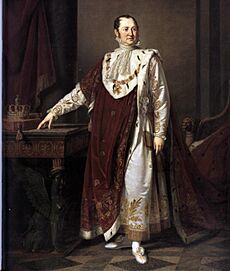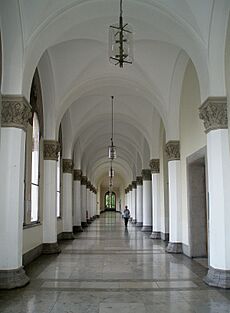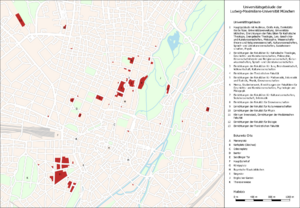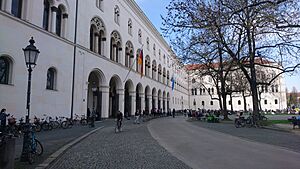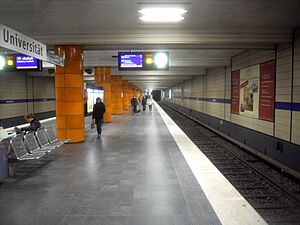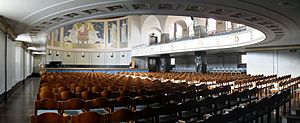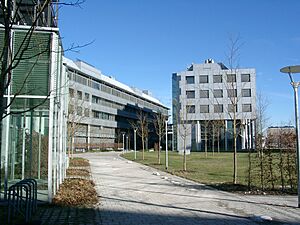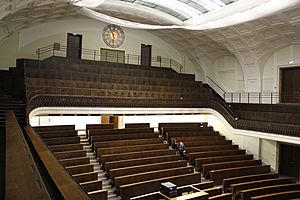Ludwig Maximilian University of Munich facts for kids
|
Ludwig-Maximilians-Universität München
|
|
 |
|
| Latin: Universitas Ludovico-Maximilianea Monacensis | |
| Type | Public |
|---|---|
| Established | 1472 |
| Budget | €797.4 million (2022) |
| President | Bernd Huber |
|
Academic staff
|
5,565 (2018) |
|
Administrative staff
|
8,208 (2018) |
| Students | 52,972 (WS 2023/24) |
| Location |
,
Bavaria
,
Germany
48°09′03″N 11°34′49″E / 48.15083°N 11.58028°E |
| Nobel Laureates | 43 (October 2020) |
| Colours | Green and white |
| Affiliations |
|
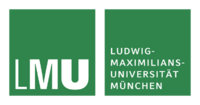 |
|
The Ludwig Maximilian University of Munich, often called LMU Munich, is a large public university in Munich, Germany. It is one of Germany's oldest universities, first opened in 1472.
The university started in Ingolstadt but moved to Landshut in 1800 because of threats from the French army. Later, in 1826, it moved to its current home in Munich. In 1802, it was named Ludwig-Maximilians-Universität to honor its founders, Duke Ludwig IX of Bavaria-Landshut and King Maximilian I Joseph of Bavaria.
LMU Munich is one of the biggest universities in Germany. In the winter of 2023/24, over 52,000 students were studying there. About 28% of these students came from other countries. The university had a budget of about 797.4 million euros in 2022.
Many famous people have been connected to LMU Munich. As of 2023, 44 Nobel Laureates have studied or worked there. These include famous scientists like Wilhelm Röntgen and Max Planck. Other well-known people include Pope Benedict XVI and writer Thomas Mann. LMU is also recognized as a "University of Excellence" in Germany.
Exploring the University's Past
Early Beginnings: 1472–1800
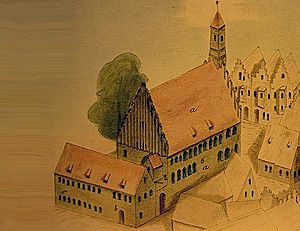
The university first opened in 1472 in Ingolstadt. It was founded with permission from the Pope by Duke Louis IX the Rich. It had departments for philosophy, medicine, law, and theology. Its first leader was Christopher Mendel of Steinfels.
During the time of German humanism, important thinkers like Conrad Celtes taught here. From 1549 to 1773, the university was strongly influenced by the Jesuits. It became a key place for the Counter-Reformation, a movement to strengthen the Catholic Church.
Towards the end of the 1700s, the university was shaped by the Enlightenment. This led to more focus on science.
Moving and Growing: 1800–1933
In 1800, the university moved to Landshut to escape French attacks. In 1802, it was officially named Ludwig Maximilian University. This honored its two founders, Duke Louis IX and King Maximilian I.
In 1826, the university moved again to Munich, the capital of Bavaria. It was first in the Old Academy building. Later, a new main building was finished on Ludwigstraße.
In the late 1800s, the university became very famous in Europe. Many top scientists came to work there. It also grew a lot. From 1903, women were allowed to study at Bavarian universities. By 1918, nearly one-fifth of LMU students were women. In 1918, Adele Hartmann became the first woman in Germany to earn a higher doctorate at LMU.
During the Weimar Republic (the German government between 1918 and 1933), LMU remained a leading university. Professors like Wilhelm Röntgen and Max Planck taught there.
A Difficult Time: 1933–1945
During the Third Reich, the freedom to teach and learn was greatly limited. In 1943, a brave group of students called the White Rose spoke out against the Nazis. They were based at this university. One of their members, Kurt Huber, was a professor who lost his job and degree after being arrested.
Modern Era: 1945–Present
After World War II, LMU continued to be one of Germany's top universities. It has remained a leader in research and education.
Today, LMU Munich is involved in many research projects. It gets a lot of funding for its studies. The university offers a wide variety of subjects, with over 150 different study programs. About 15% of its students come from other countries.
In 2005, Germany started the German Universities Excellence Initiative. This program gives money to top universities to support research and education. LMU Munich has received funding from this initiative for its excellent graduate schools and research areas. In January 2012, LMU scientists created the most sensitive listening device known, earning a spot in the Guinness Book of World Records.
Exploring the Campus
LMU's buildings are located all over Munich. Some are in the suburbs like Oberschleissheim and Garching. The main buildings are found around Geschwister-Scholl-Platz and Professor-Huber-Platz on Ludwigstrasse.
Other large campuses include LMU Klinikum – Campus Großhadern (the hospital) and the chemistry and biotechnology campus in Martinsried. The main university building is easy to reach by subway, at the Universität station.
The Great Assembly Hall (Große Aula)
The Große Aula is a beautiful hall in the main university building. It was built in 1840 and was not destroyed during World War II. This made it one of the few places in Munich that could be used for concerts and meetings right after the war.
The Aula was even used for the meeting where the current constitution of Bavaria was created. Today, it is still used for concerts, talks, and lectures.
What Can You Study?
Fields of Study
LMU Munich offers more than 100 different subjects to study. You can combine many of these subjects as your main and minor areas of study.
To help students from other countries, more and more courses are now taught in English. This is especially true for advanced studies like psychology, physics, and business.
University Departments (Faculties)
The university has 18 main departments, called faculties. These faculties oversee many smaller departments and institutes. Some numbers are missing from the list because departments have merged or changed over time.
Here are some of the faculties:
- 01 Faculty of Catholic Theology
- 02 Faculty of Protestant Theology
- 03 Faculty of Law
- 04 Faculty of Business Administration
- 05 Faculty of Economics
- 07 Faculty of Medicine
- 08 Faculty of Veterinary Medicine
- 09 Faculty for History and the Arts
- 10 Faculty of Philosophy, Philosophy of Science and Study of Religion
- 11 Faculty of Psychology and Educational Sciences
- 12 Faculty for the Study of Culture
- 13 Faculty for Languages and Literatures
- 15 Faculty of Social Sciences
- 16 Faculty of Mathematics, Computer Science and Statistics
- 17 Faculty of Physics
- 18 Faculty of Chemistry and Pharmacy
- 19 Faculty of Biology
- 20 Faculty of Geosciences and Environmental Sciences
Research Centers
Besides its faculties, LMU Munich has many research centers. These centers work on projects that involve different subjects and departments. Some centers are partnerships with other famous groups. For example, the Rachel Carson Center for Environment and Society was created with the Deutsches Museum.
Some of the research centers include:
- Center for Integrated Protein Science Munich (CIPSM)
- Graduate School of Systemic Neurosciences (GSN)
- Helmholtz Zentrum München – German Research Center for Environmental Health
- Nanosystems Initiative Munich (NIM)
- Parmenides Center for the Study of Thinking
- Rachel Carson Center for Environment and Society
Costs to Study
Universities in Bavaria, where Munich is located, do not charge tuition fees. Students only pay a small semester fee. This fee goes to the student union, which helps provide things like housing and food options for students.
University Rankings
| University rankings | ||||||||||
|---|---|---|---|---|---|---|---|---|---|---|
| Overall – Global & National | ||||||||||
|
||||||||||
LMU Munich is highly ranked among universities worldwide. In 2025, the QS World University Rankings placed LMU 59th globally and 2nd in Germany. It is especially strong in arts, humanities, natural sciences, and life sciences.
The Times Higher Education Ranking for 2024 put LMU Munich 38th in the world and 2nd in Germany. It was ranked first in Germany for arts, humanities, law, and psychology.
The Academic Ranking of World Universities ranked LMU Munich 43rd globally and joint 2nd in Germany in 2023. It was first in Germany for subjects like physics, education, and communication.
LMU Munich also ranks high in terms of research funding. From 2017 to 2019, it received the most grants from the German Research Foundation among German universities.
|
|
|||||||||||||||||||||||||||||||||||||||||||||||||||||||||||||||||||||||||||||||||||||||||||||||||||||||||||||||||||||||||||||||||||||||||||||||||||||||||||||||||||||||||||||||||||||||||||||||||||||||||||||||||||||||||||||||||||||||||||||||||||||||||||||||||||||||||||||||||||||||||||||
Working Together: One Munich Strategy Forum
LMU Munich and the Technical University of Munich work together on something called the "One Munich Strategy Forum." They received 2.5 million euros from the state of Bavaria for this project.
Summer Programs: Munich International Summer University
The Munich International Summer University (MISU at LMU) offers short courses for students from all over the world. These programs happen every year in Munich. They allow international students to study at LMU during their breaks from their home universities.
MISU offers German language classes and 16 different subject-specific Summer and Winter Schools. These cover many academic areas. In 2019, about 1000 students from nearly 90 countries joined MISU programs.
LMU Munich has offered summer programs for international students since 1927. The goal of MISU is to make LMU Munich even more international in its research and teaching. These short programs give students a deep look into LMU's research and campus life. MISU also combines great academic learning with fun activities. Students learn about the history, culture, and politics of Munich and Germany. These programs help LMU become even more well-known as a top university in Europe.
Famous People from LMU Munich
Many important people have studied or taught at LMU Munich. They have made big contributions to science, literature, and other fields.
For example, Max Planck, who created quantum theory and won the Nobel Prize in Physics in 1918, was a student here. Other key figures in quantum mechanics, like Werner Heisenberg and Wolfgang Pauli, were also connected to the university.
More recently, the building for Physical Chemistry was named after Gerhard Ertl. He won the Nobel Prize in Chemistry and was a professor at LMU from 1973 to 1986.
Sir Muhammad Iqbal, a famous philosopher and poet from Pakistan, earned his PhD from LMU Munich in 1908. He is known as the "Poet of the East."
The brave anti-Nazi resistance group called the White Rose was based at this university.
Images for kids
-
Pope Benedict XVI was a student and professor at LMU Munich.
-
Wilhelm Conrad Röntgen received the Nobel Prize in Physics in 1901.
-
Ferenc Krausz received the Nobel Prize in Physics in 2023.
-
Theodor W. Hänsch received the Nobel Prize in Physics in 2005.
-
Otto Hahn received the Nobel Prize in Chemistry in 1944.
-
Werner Heisenberg received the Nobel Prize in Physics in 1932.
-
Max Planck received the Nobel Prize in Physics in 1918.
-
Hans Bethe received the 1967 Nobel Prize in Physics.
-
Nobel Prize-winning novelist Thomas Mann gave numerous lectures at LMU Munich.
-
Karl Jaspers was a German-Swiss psychiatrist and philosopher.
-
Philosopher, Persian and Urdu poet Sir Muhammad Iqbal studied philosophy at LMU Munich.
-
Blake Ragsdale Van Leer, United States Army officer and president of Georgia Institute of Technology
-
Konrad Adenauer was Chancellor of Germany from 1949 to 1963.
-
Valdas Adamkus, President of Lithuania 1998–2003 and 2004–2009
-
Bertolt Brecht, poet, playwright and theatre director
-
The sociologist Max Weber was a professor at LMU Munich.
-
Heinrich Brüning served as Chancellor of Germany during the Weimar Republic from 1930 to 1932.
See also
 In Spanish: Universidad de Múnich para niños
In Spanish: Universidad de Múnich para niños
- Education in Germany
- List of forestry universities and colleges
- List of modern universities in Europe (1801–1945)
- List of universities in Germany


